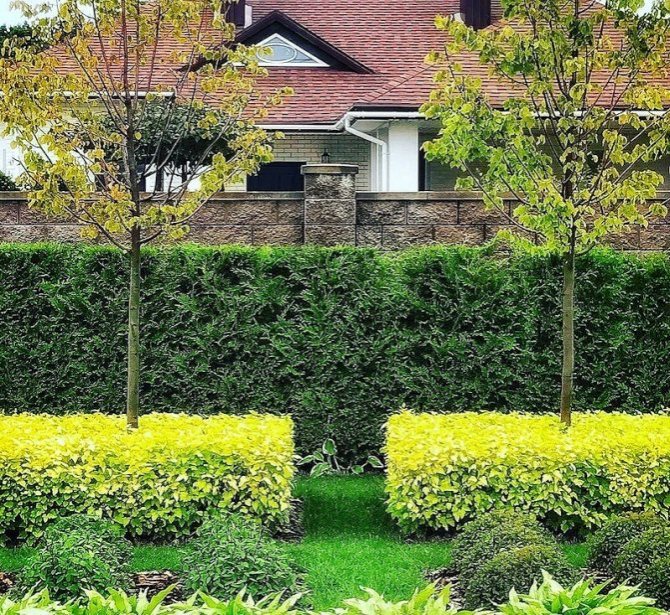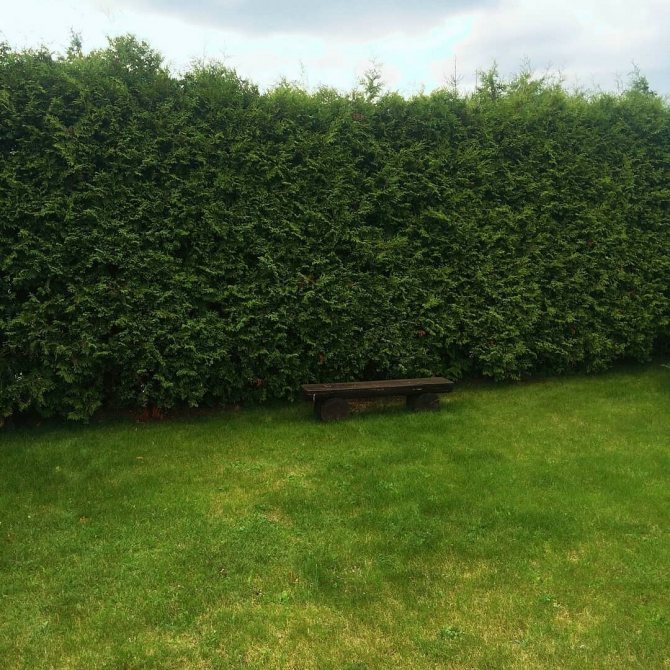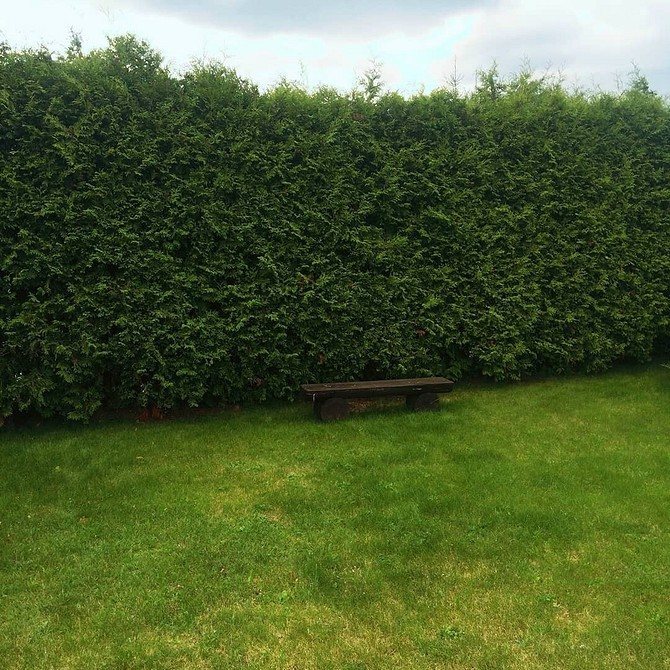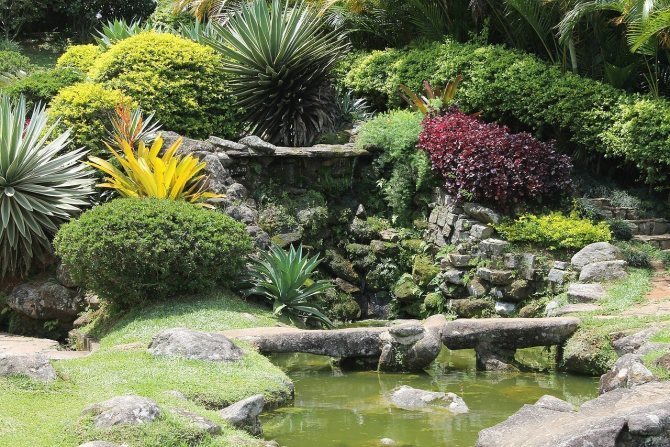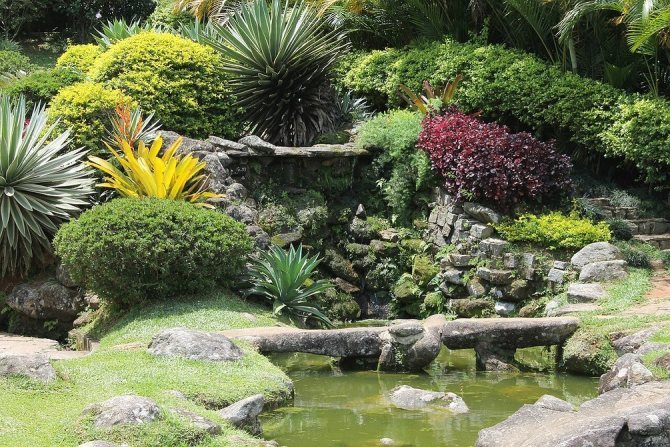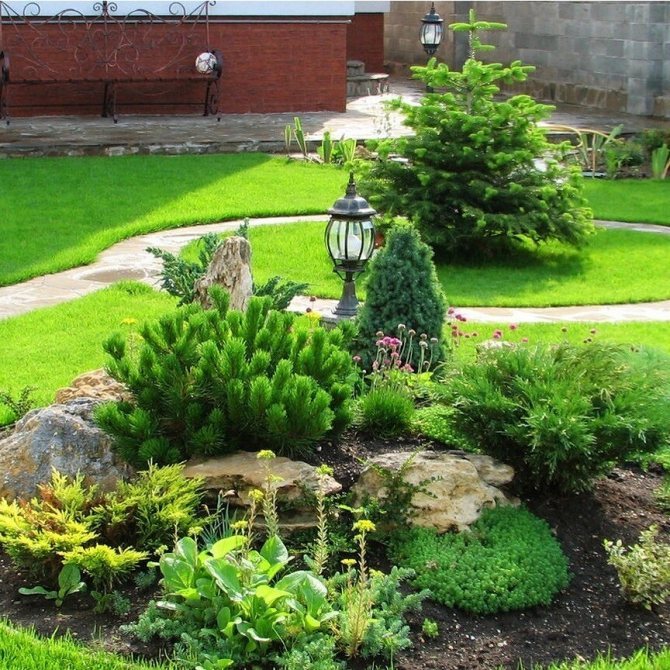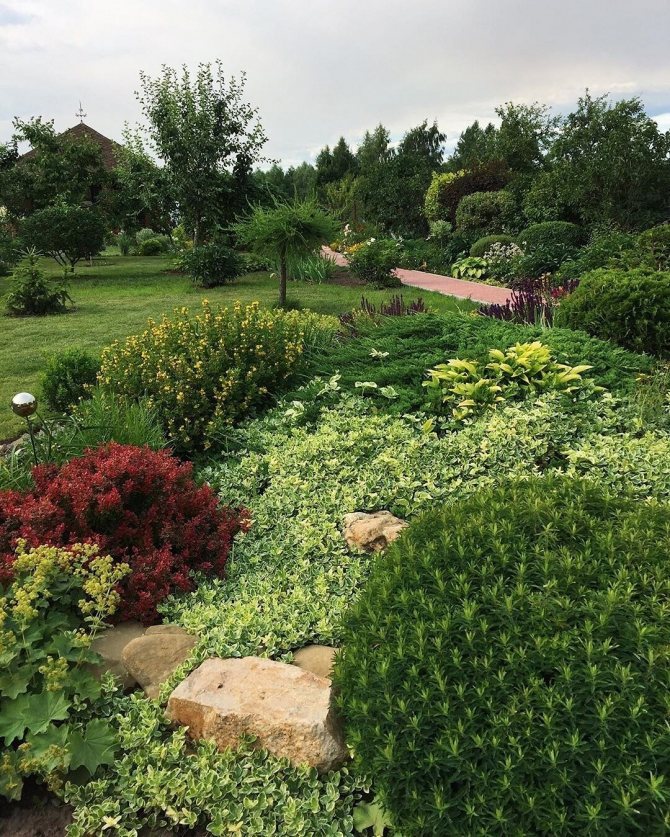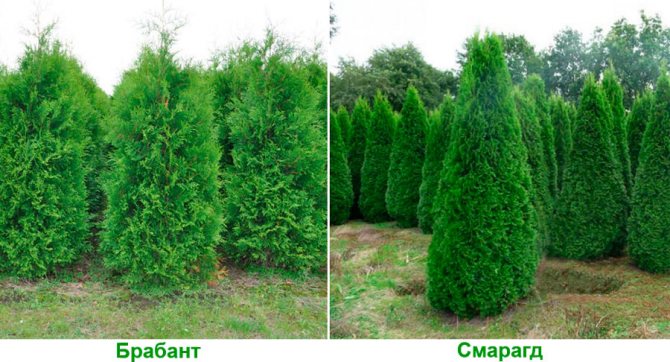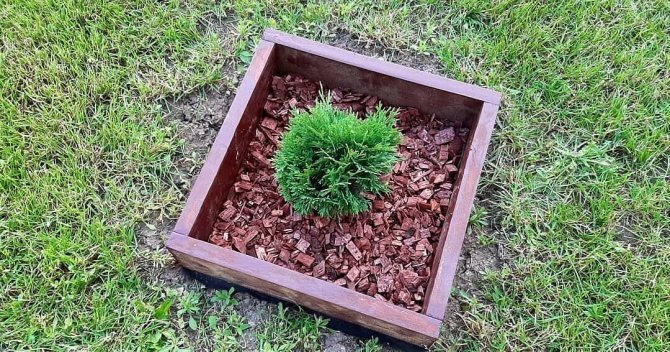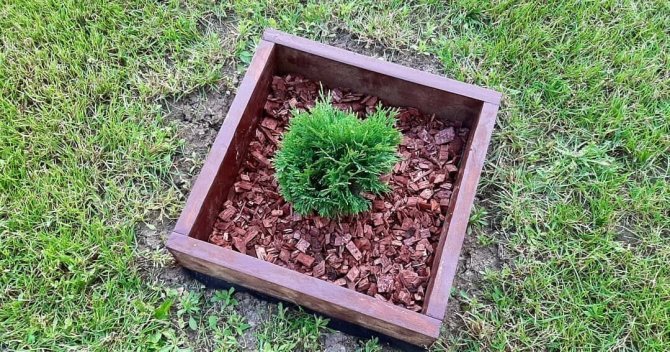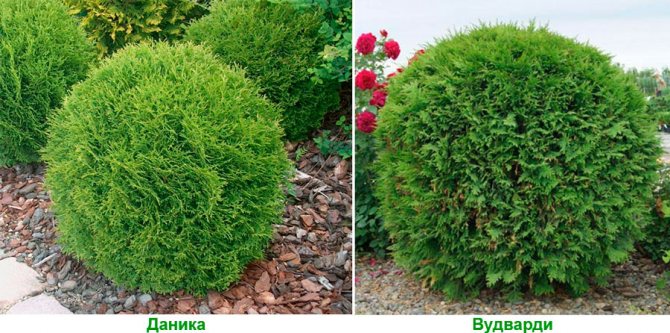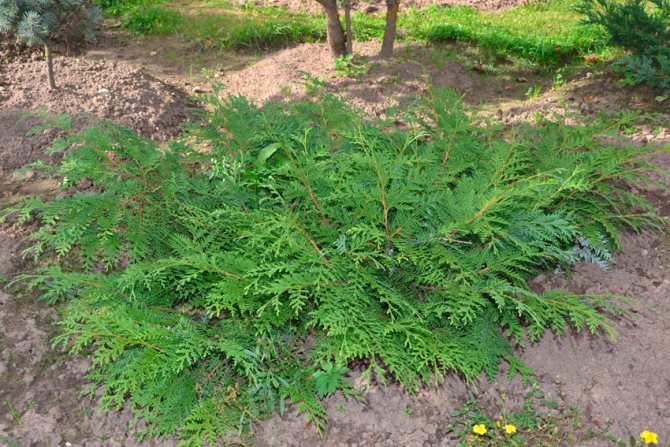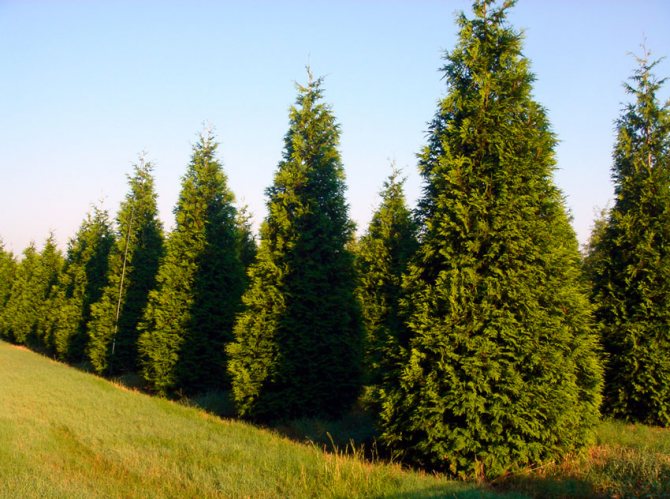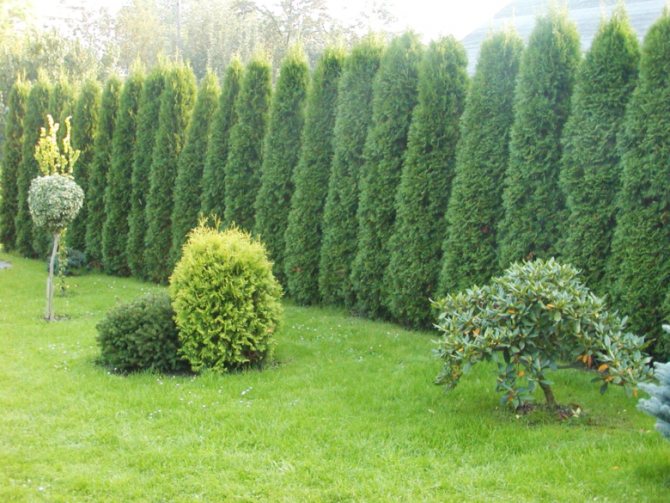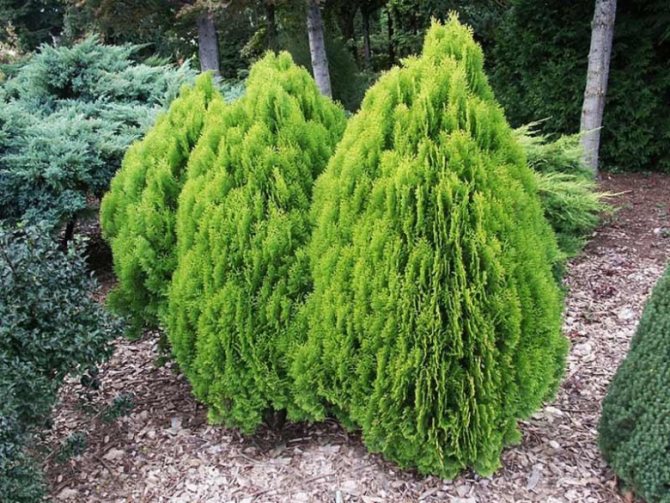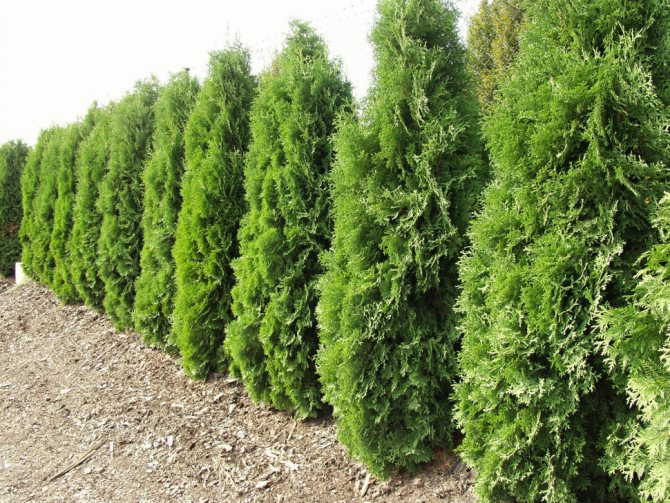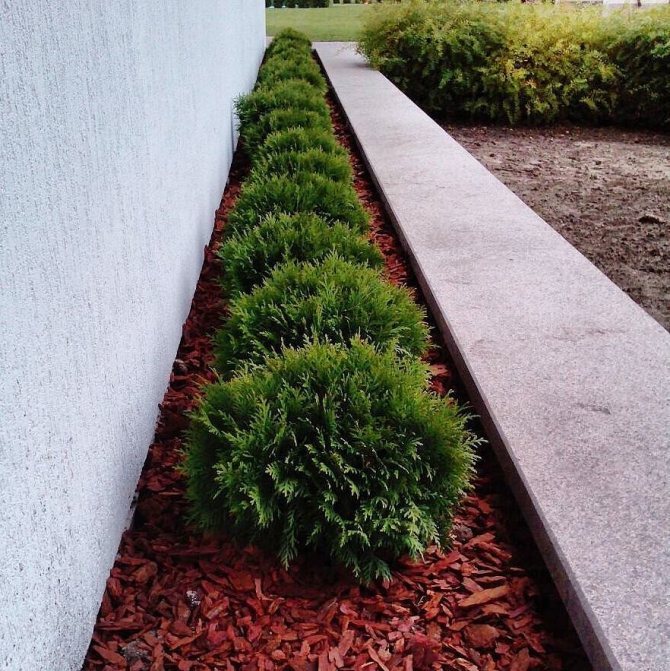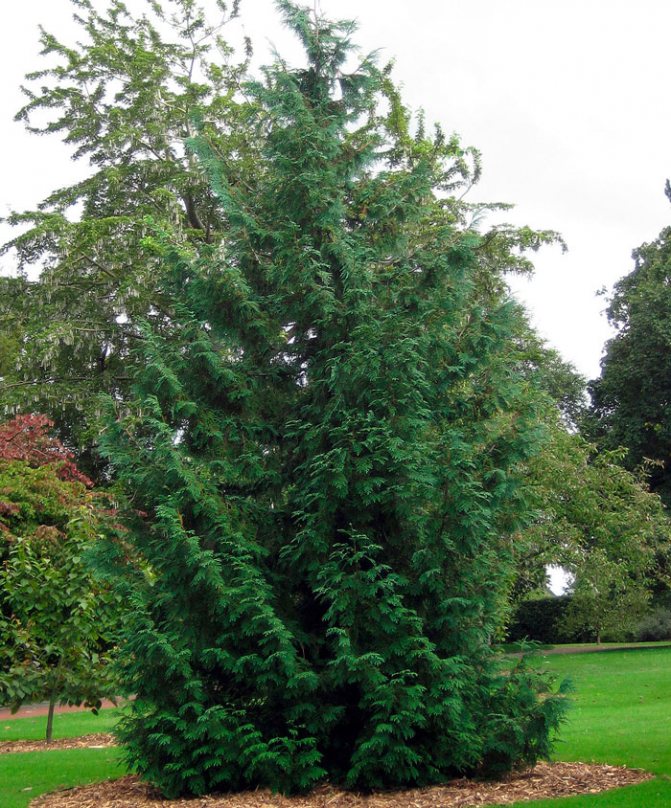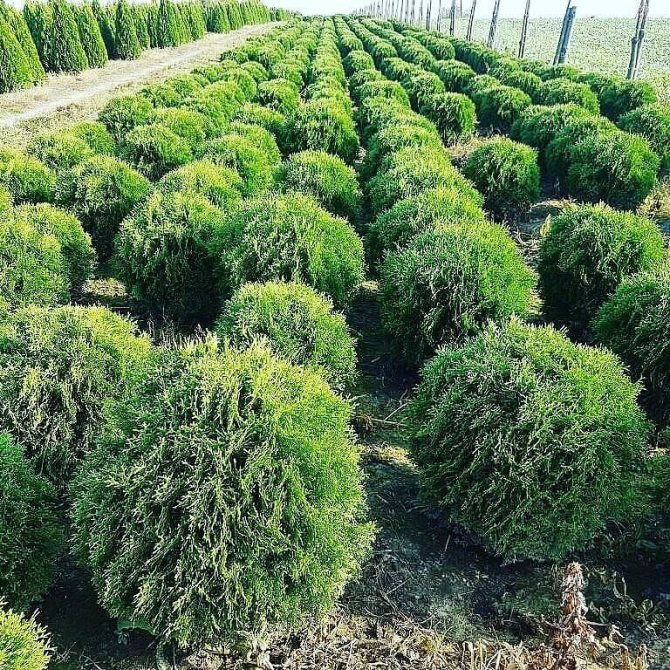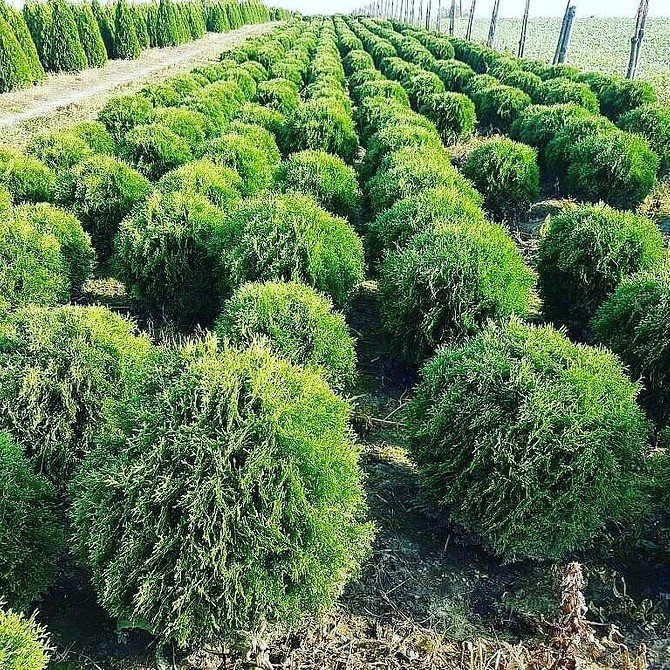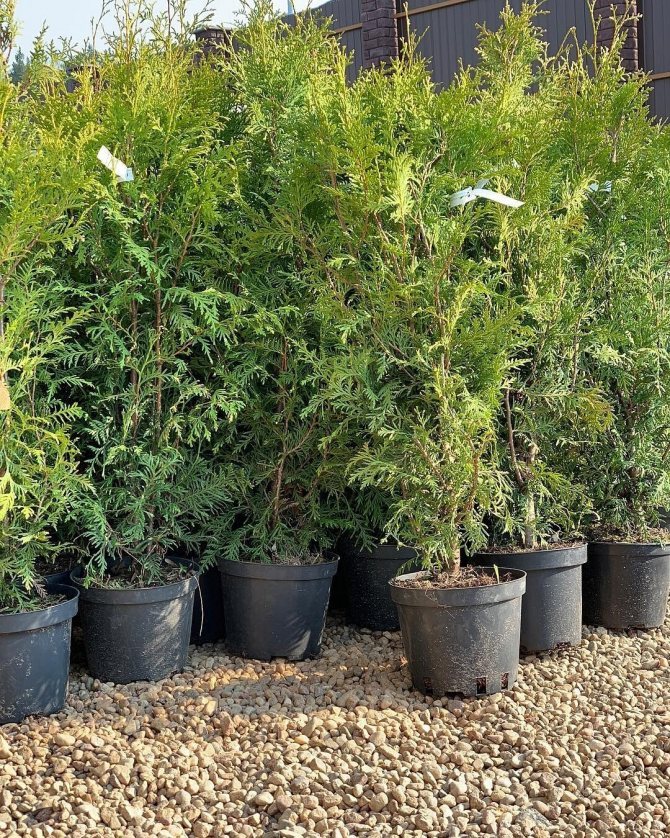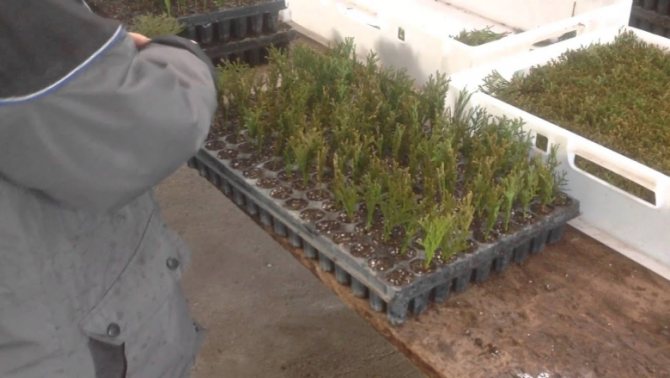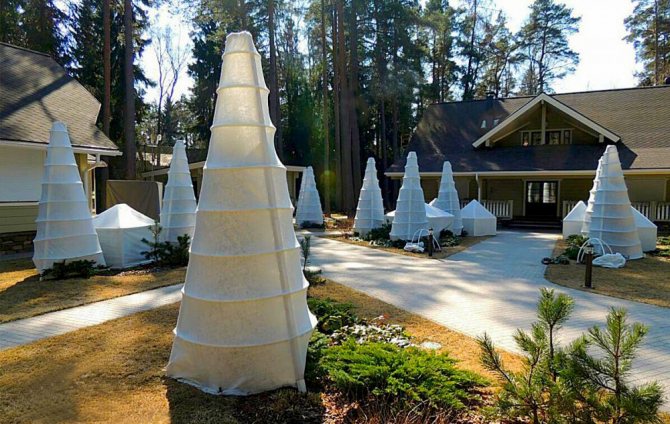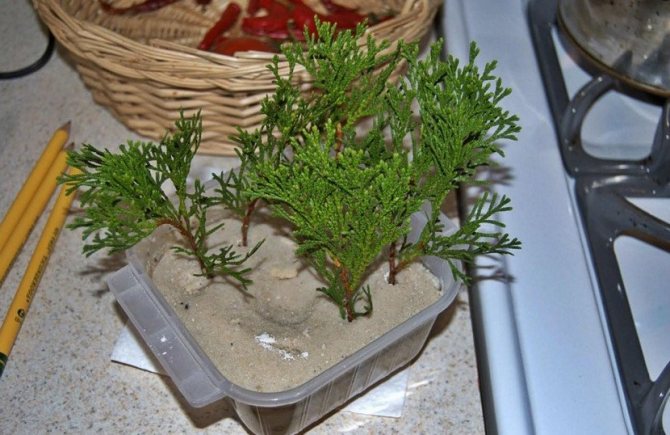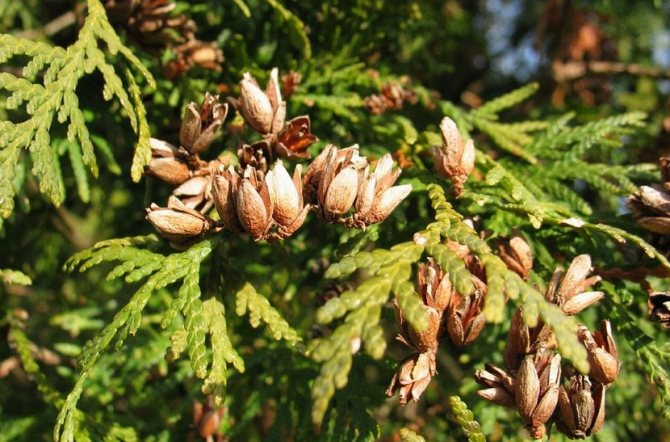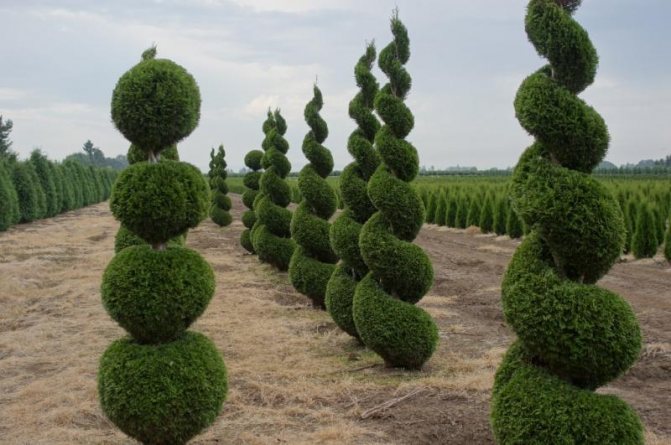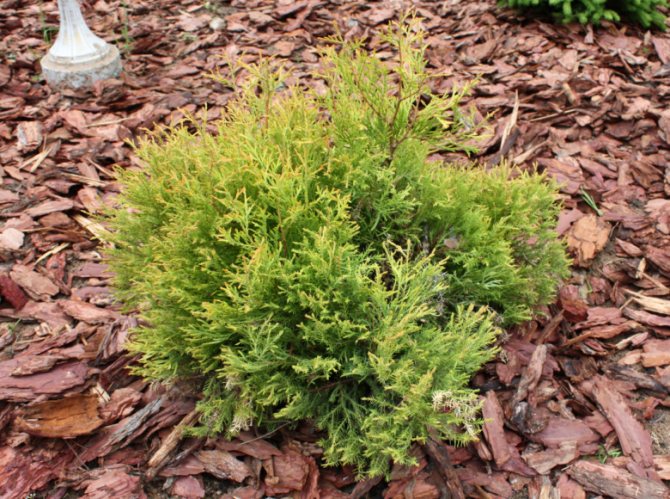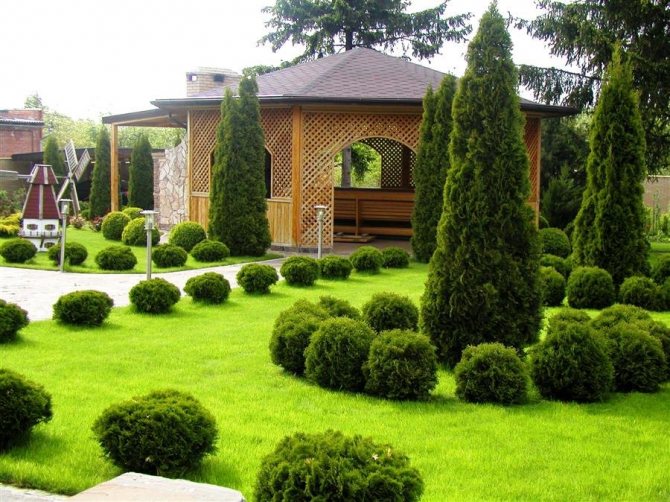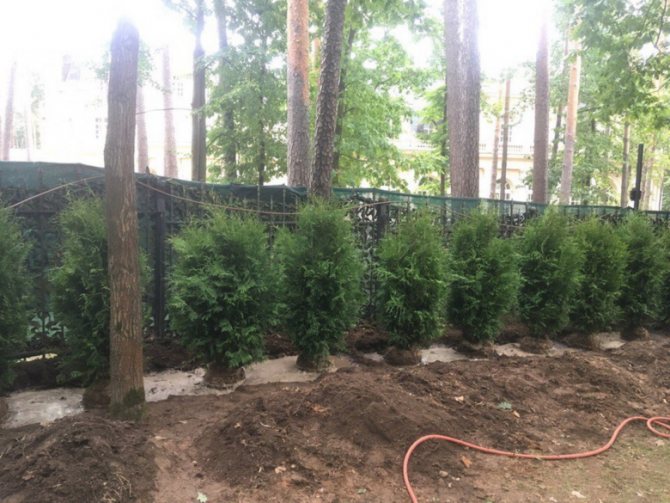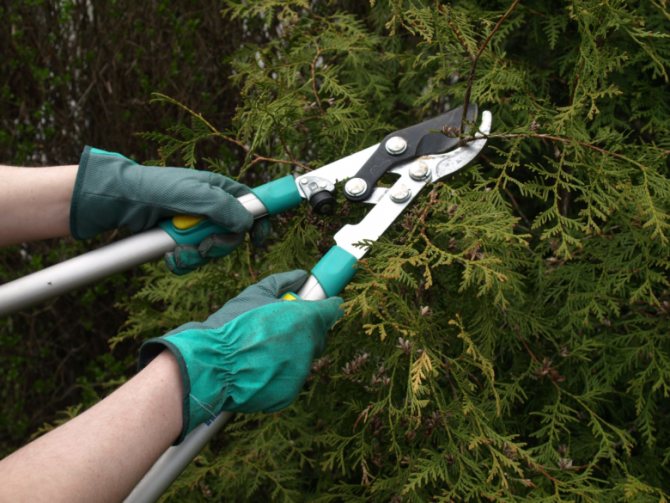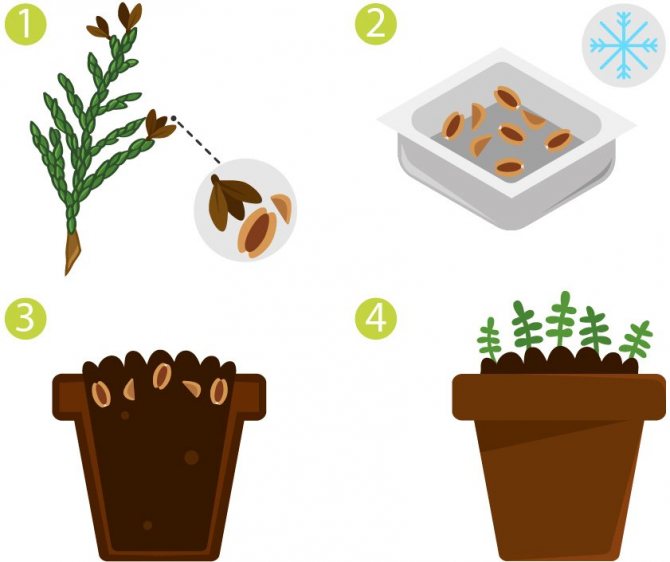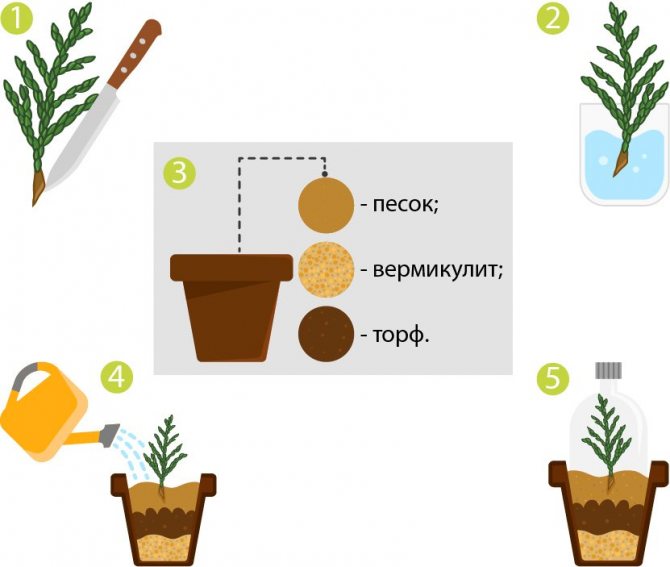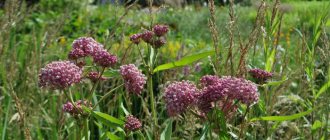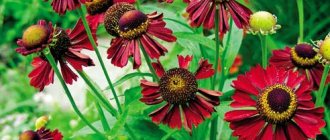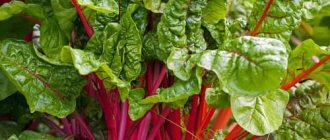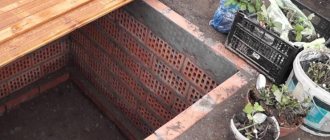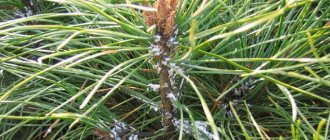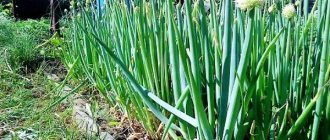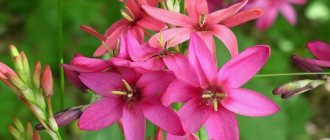Experienced gardeners have long been using not only beautiful, but also useful plants and shrubs for planting in their summer cottage. Thus, thuja gained popularity - an evergreen perennial plant that releases phytoncides into the atmosphere, which have antimicrobial properties.
Planting and caring for thuja outdoors for experienced gardeners is not difficult. That is why thuja can also be planted at home, where the features of care may differ slightly.
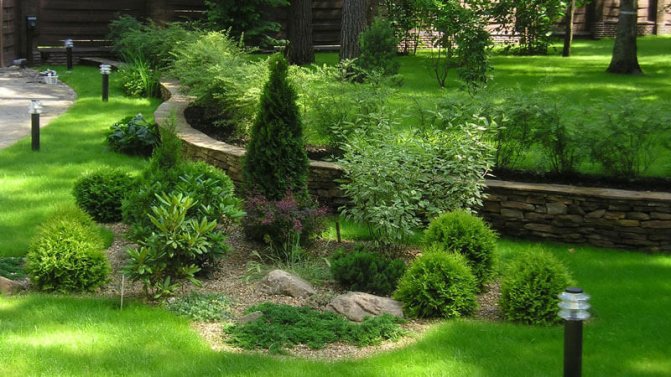
Suitable dates for spring planting of thuja
When is it better to plant coniferous seedlings, in what month? It is necessary to be guided by the weather conditions. It is optimal to do this after the earth has warmed up enough, but the air temperature will not be more than 15 degrees Celsius. The optimal timing for planting thuja in open ground in spring varies in different regions:
- In the middle lane (Moscow region) - it is better to plant in the middle or end of April.
- In the South (Krasnodar Territory (Kuban), North Caucasus) - The best time for the procedure is at the end of March or beginning of April.
- In Siberia, the Urals, the Leningrad region - in the beginning of May.
When is it better to plant thuja in the garden: in spring or autumn? You can plant a coniferous shrub without problems in both cases. The main thing is to observe the optimal time for the procedure. It is believed that in the south it is better to plant in autumn, but in cooler regions (Moscow region, Siberia, Ural, Leningrad region) - in spring.
Design ideas
Green hedge
If your dream is to get a solid green hedge, choose varieties such as Brabant, Kornik, Frieslandia, Yellow ribbon, Wagneri, Litomysl. They should be planted at a distance of at least 50 cm from each other, cut off the tops so that the trees bush wide. The distance from the fence should be at least 1 m.
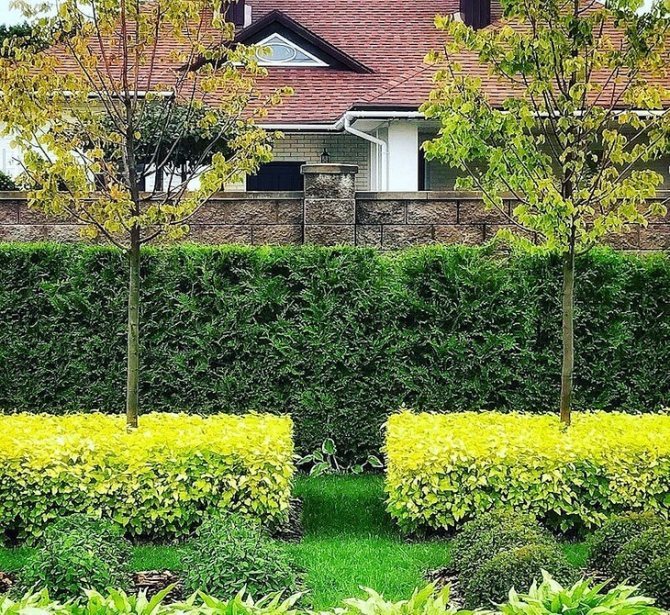

Instagram @ daria.familyhouse
Alpine slide
Tui are perfect for planting on an alpine slide. For this purpose, it is better to use dwarf varieties Danica, Aurea Nana, Whipcord, Glauca Prostrata, Hoseri. They are unpretentious, do not require special care and frequent watering. The composition can be decorated with flowers - lavender, barberry, irises.
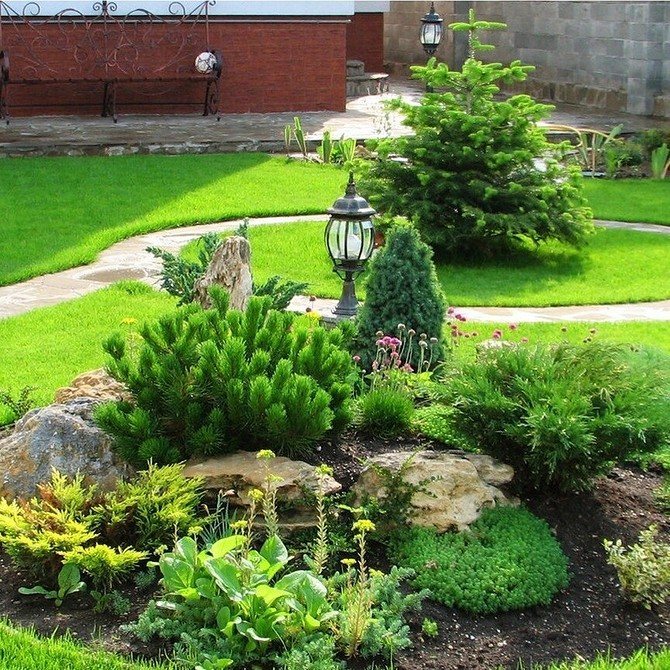

Instagram @ ldizain23
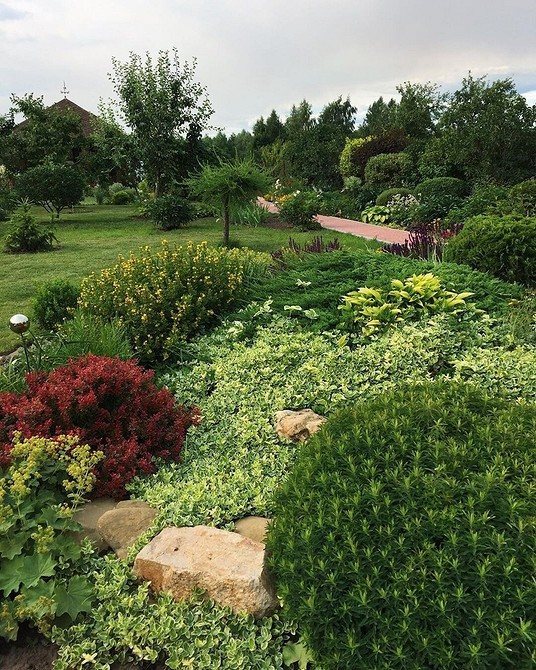

Instagram @vmoemsadu
How to choose a good and high quality thuja seedling
Regardless of the horticultural culture, quality planting material is an important component of successful planting and subsequent survival. Thuja in this case is no exception. A seedling can be bought at almost any garden center or specialized point of sale. As a rule, it is sold with a closed root system (Z.K.S.), that is, in a container (in a pot), but it is found simply with a lump of earth wrapped in material. Variant with a closed root system in a container more welcomed, as it is more convenient and of better quality.
The following recommendations will help you choose the right quality thuja seedling for planting in spring and summer:
- The seedling must be healthy, there must be no signs of disease, damage to the bark, or shoots.
- It is best to choose an instance that has a symmetrical shape.
- Adult specimens with a closed root system should have a well-developed root system and a lush crown (of course, the first indicator is difficult to check, but the second is without problems).
- Ask the seller about the age of the planting material.It is recommended to buy a seedling up to three to four years old, it will take root and grow faster.
- If you see a seedling with a closed root system (Z.K.S.), carefully examine the bottom of the pot and the surface of the ground - the roots should not stick out strongly from the drainage holes or the surface of the soil (if they stick out quite a bit, then it's okay). If you nevertheless come across such a specimen, then it is better to bypass it, because it has been languishing in this container for a long time.
Advice! You can assess the vitality of a seedling using a simple method: gently squeeze the needles with your hand and squeeze for a couple of seconds. If, after you release the needles, it immediately straightens up and takes its former shape, then it means that it is healthy.
- Pay attention to the needles of the seedling: it should be green (except varieties with yellowish and golden needles). The brown color most likely indicates a deficiency of nutrients during storage of the seedling, so such specimens should be avoided.
- Ask the seller if it is possible to remove the earthen lump from the container. If the answer is yes, be sure to examine the roots on the earthen coma. In a good seedling, they should be white with a slight pink tint. You should refuse to buy a copy with brownish and soft roots.
Advice! When choosing a thuja seedling, you must carefully examine the specimen you like to avoid unpleasant surprises.
Preparatory work
How to choose a seedling
It is better to choose seedlings grown in pots: they take root better, since their roots are not chopped off, and when they are removed from the pot and planted in the ground, the roots will grow in a circle. You should not buy large seedlings - it will turn out too expensive and, moreover, it does not make sense: on average, thuja add 40 centimeters per season, so they will become tall very quickly.
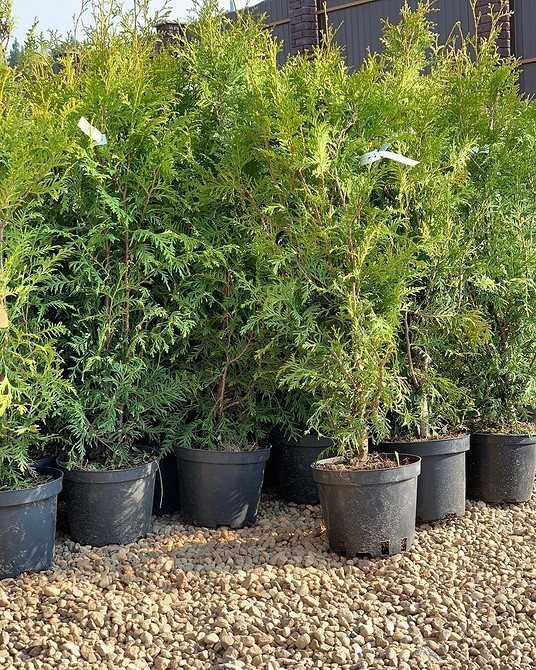

Instagram @ flora.desigh
Step-by-step instructions for planting thuja in spring and summer
Competent planting of thuja in open ground is not only the process itself, but also preparation for the event, which has its own characteristics and rules. Necessary preparatory procedures include site selection, soil preparation and pit preparation. Let's consider all each step in detail.
Choosing a place and soil for planting
Each crop (vegetable, berry, flower) has its own preferences in terms of where it is grown. Someone likes it in the shade and in the humidity, someone suits exclusively the sunniest place. Therefore, before planting a seedling in open ground, you need to responsibly approach the choice of a site, otherwise the shrub will grow slowly, and the appearance will leave much to be desired. So, you can choose the right place and soil for planting thuja according to the following criteria:
- Lighting is very important for this culture - the place should be well lit by the sun. However, cultivation is possible in the shade, but in this case, the coniferous shrub will thin out and lose its splendor. But if you live in a region with hot and dry summers, for example, Volgograd, Astrakhan, Rostov regions, etc., then you can plant in an area with little shade.
- The place should be protected from winds and drafts, so it is better not to choose too open areas.
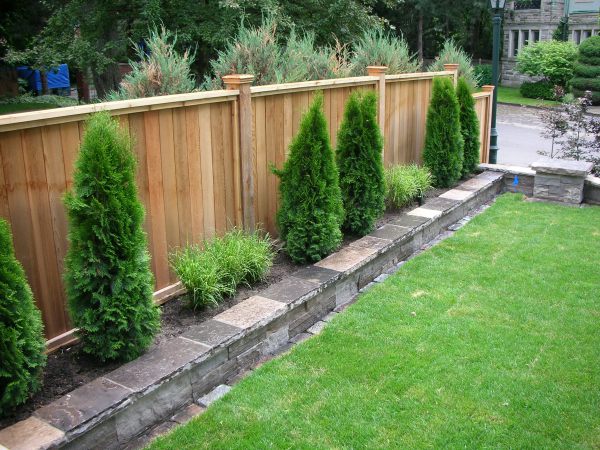

- The ideal soil for growing thuja is light, fertile, with good air and moisture permeability (i.e. well-drained soil). The crop also loves acidic soil (pH 5-6).
- Heavy, clayey soils should be avoided. And also excessively wet or dry (in the latter case, they can easily dry out, turn yellow, and even begin to crumble).
- The site should not have a high occurrence of groundwater (no higher than 1 meter), because the culture does not tolerate waterlogging of the soil. For the same reason, lowlands and simply areas with excessive moisture should be avoided.
- You should not plant thuja next to trees, since the root system of the latter will take nutrients from the soil, depriving coniferous shrubs. The optimal distance between thuja and trees is 3 or more meters.
- It is also necessary to plant shrubs in the yard, next to the fence, taking into account the minimum distance - 1-1.5 meters.
- If you already have a juniper growing on the site of a private house or in your country house, then you can plant a shrub next to it, together they look very beautiful!
Site and pit preparation
If the land on the site you have chosen is not sufficiently cultivated, then you need to clear it of stones, weed roots. It is recommended for the season (i.e. in the fall) or 1-1.5 months before planting to dig up the site. If the soil is too poor, then you can add humus or compost (1 bucket per square meter of area), if clay and heavy - sand and peat (1 bucket of each substance per square meter), if sandy, then humus or compost and peat (1 bucket of each ingredient per sq. m.)
But the above-described preparation of the place and soil is not essential, although if you do it, it will be just great, but you can do without it. The most important thing is the preparation of the landing pit, it is advisable to make it 3-4 weeks before the event (but it is also allowed on the day of the event).
You can prepare a hole for planting a thuja seedling in open ground according to the following scheme:
- The first thing to do is to dig a hole, its depth and width should be about 2 times the size of the seedling's earthen lump. The approximate depth and width of the pit is 70 centimeters (if the soil is clayey and heavy, then 80 cm). In this case, the fertile soil must be thrown into a separate pile.
- If your site has heavy, clayey soil or is simply waterlogged, with closely spaced groundwater, then you need to make a drainage layer, for example, expanded clay, broken brick, crushed stone, any stones. The layer thickness is 10 centimeters.
- Now we move on to the most important step - filling the hole with a suitable potting mix. As a dressing for the pit, you can use one of the following mixture options: Special soil for coniferous crops (also on the package it may be written "For conifers"). You can buy it at a garden center or specialty store.
- A mixture of high moor sour peat (2 parts) + sand (1 part) + fertile soil from the top layer (1 part).
- Sod land (3 parts) + sand (1 part) + high sour peat (2 parts).
- Horse sour peat (1 part) + leafy earth (2 parts) + sand (2 parts) + humus (3 parts).
Advice! It is necessary to observe the gap between the coniferous shrubs. The optimal distance between thujas when planting is about 3 meters (and for large varieties, 4-5 m).
But! If you want to make a hedge out of thuja, then plant it with an interval of about 50 centimeters between them! In this case, you can plant them in a checkerboard pattern (in this case, the distance between the rows and seedlings is 1 m), so you can get denser and denser plantings. Especially checkerboard planting is relevant if you have a lot of seedlings.
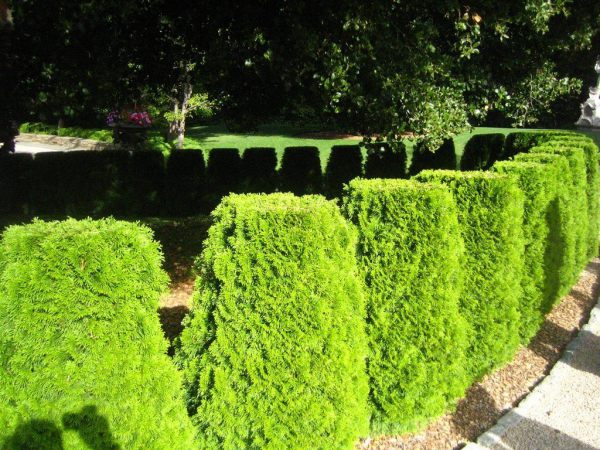

Direct planting of thuja
If you have waited for the optimal timing, prepared the place and the pit, then it is time to start the culmination event, but it is important to know the correct process technology.
So, a step-by-step description of the process of planting a thuja in open ground in spring and summer:
- 1-2 hours before the event, you need to water the container with the seedling. This will make it easier to remove the seedling from the pot.It is advisable to use a growth and root formation stimulator for watering, for example, Heteroauxin, Kornevin, Epin-Extra, Zircon.
- Then you need to very carefully remove the seedling from the pot with a lump of earth. To remove it, you can, for example, put the pot on its side and gently knock on the container with a shovel, and then gently pull it out from the bottom of the barrel.
- Place the seedling together with the earthen lump in the hole (you cannot destroy it, because you need to plant it by the transshipment method). Optimal planting depth - the root collar (the place of transition from the trunk to the root) must be strictly 3-4 centimeters above ground level... It is impossible to deepen the neck or leave it too high above the ground, otherwise the seedling will die.
If you put a seedling in a hole, and the root collar turned out to be deeper or higher than necessary, then you should raise the planting material and, accordingly, add or remove a little earth.
- If you purchased a thuja seedling open-rooted, then you must first make a mound in the center of the pit and put the planting material on it. Spread out the roots, they should lie flat.
- Now you need to fill the hole with the seedling halfway (using the soil that you prepared earlier for filling the hole).
- Water the pit abundantly, wait for the water to absorb.
- Then you need to re-fill the hole with soil, but now the soil in the hole should be equal to the ground.
- Lightly compact the soil around the seedling.
- Mark the area for the watering circle by making a roller of earth in a circle.
- Do the final watering, you need to use 2-3 buckets of water. For better rooting, you can use a growth stimulant solution, for example, Zircon, Kornevin, Epin-Extra.
- Mulch the trunk circle. As mulch, you can use high moor sour peat, pine bark or coniferous litter (they additionally acidify the soil), or rotted sawdust, wood chips.
Note! You can remove a seedling with a clod of earth from the pot only immediately before planting. Do not leave it without a container in the open air for more than 10 minutes. Otherwise, the roots will begin to dry out, and this will adversely affect the health or even vitality of the shrub.
Plant species
One of the most popular conifers of our time has more than 120 different varieties, which differ in size, shape, and color of needles. Most of them are created by crossing different types of thuja. The interest of breeders in this culture is understandable - the demand for such unpretentious beauty is too great. Due to its purely decorative features, thuja is often used in landscape design. And not without reason, because it has a lot of advantages:
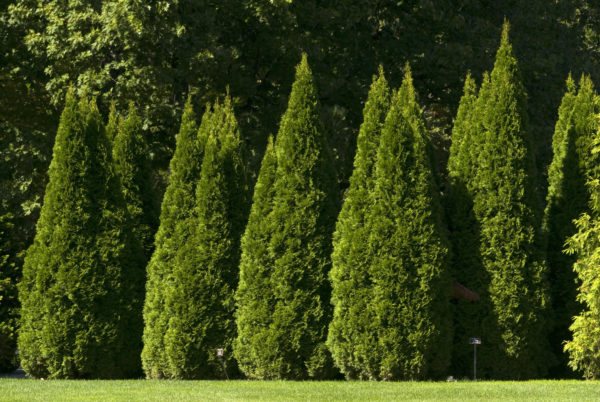

- the tree does not change its juicy green color either in winter or in summer;
- soft twigs with numerous leaves exude a dizzying aroma of essential oils;
- the plant requires a minimum of costs and effort for care, as it is very unpretentious;
- thuja has been pleasing to the eye for decades.
Note: thuja does not grow in Russian forests.
The most successful among domestic gardeners are the types of thuja "eastern" and "folded".
Thuja orientalis (Thuja orientalis)
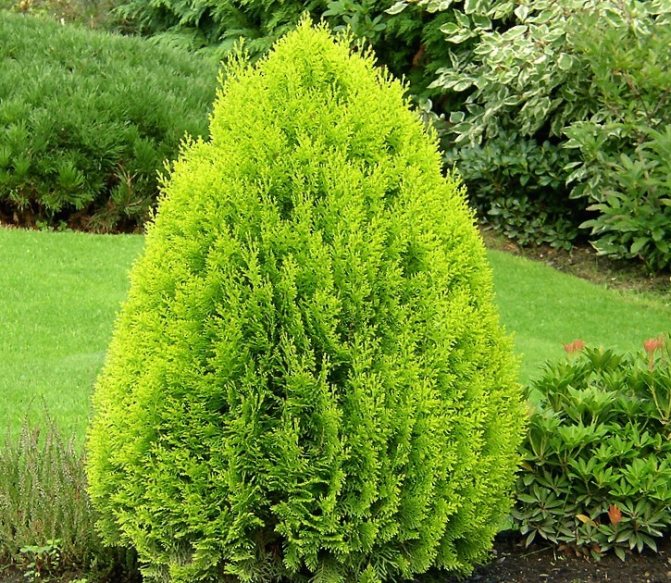

Eastern thuja is a coniferous plant called in botany the Oriental Platycladus (Platycladus orientalis) or Oriental Biota (Biota orientalis). It is widely found in Korea and China, grows in the wild in the steppes on poor soils. Such a thuja can grow for several hundred years, practically without changing its appearance. It develops very slowly, has the shape of an ordinary tree, reaches 5-10 meters in height. In cold climates it takes the form of a bush. The crown is wide downwards and very narrow at the apical part. Scaly needles, bright green. Young plants are "prickly", like a herringbone. In winter, the eastern thuja changes its outfit to golden or brown.
Popular varieties
| name | characteristic |
| Aurea Nana | A dwarf variety that grows mainly in warm climates. Designers love to use this variety because of the dazzling green of the leaves, the cone-shaped crown, which turns into an ovoid over the years, and the slow development. An adult plant grows up to 1.5 meters tall. In winter, the needles change their color to yellow with shiny, playful notes. Cold temperatures are detrimental to this thuja, therefore, for the winter, the plant should be carefully covered and the ground should be mulched. Aurea Nana is capable of showing all her beauty only on fertile, light and moist soils and in lighted areas. thuja |
| Justynka | Columnar thuja of the undersized type. The height of a mature plant reaches no more than 120 centimeters. The crown is dense and dense, practically does not require pruning. Yustinka winters well in the central regions, tolerates dry periods painlessly, and never gets sick. Suitable for any type of landscaping. |
| Morgan | The pyramidal stately plant is the brainchild of Australian scientists. The branches are golden in color, which takes on a reddish-bronze hue in winter. A low-growing variety, the height of the plant does not even reach a meter. The growth is very small - 5 centimeters. Ideal for curbs and front gardens. |
Thuja western (Thuja occidentalis)
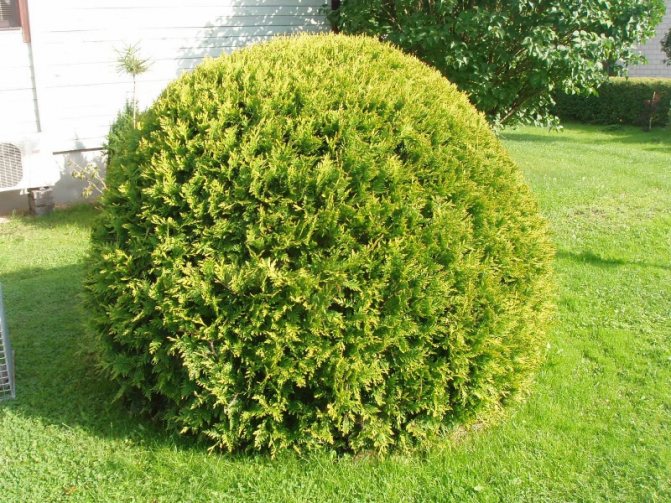

This variety is distinguished by the height of the tree - up to 20 meters. Western thuja is called due to its origin and habitat - North America. The crown of its strict pyramidal shape becomes softer with age. Its reddish bark is tough, often cracked, hanging down the trunk. The foliage is dark green, soft. Cones up to 1.5 centimeters long ripen in autumn.
Popular variety
| name | characteristic |
| Emerald | A strong, powerful 5-meter tree looks like a cypress (thuja is a member of the cypress family). Foliage color - emerald. It does not change all year round. The variety is very unpretentious, frost-resistant, with strong immunity. Grows successfully on any type of soil. The only condition for leaving is protection from direct sunlight. But it cannot grow in the shade. Variety of very long growth, shoots grow only 10 centimeters per year. Ideal for decorating hedges. |
| Golden Smaragd | A variety of the Smaragd variety. Differs in the golden color of the branches. The maximum tree height is about two meters. The crown is predominantly conical, dense, dense. The plant develops well in nutritious, drained, moist soil. Poor ecology affects development - it slows down, the appearance becomes sick. The variety is great for country decor. It can grow in any climate. Very hardy. |
| Danica | The Danish variety was bred in 1948. A spherical undersized shrub with lush green wavy foliage and soft fan-shaped twigs exuding a delicate aroma of needles. In winter, the greens turn brown. The height of the plant does not exceed one meter. An increase of no more than five centimeters per year. Optimally suitable variety for arranging rockeries, growing along curbs. |
| Aurea Danica | The submouth of Danica Aureya is distinguished by a more yellowish tint of branches and leaves. In leaving, Aureya is also unpretentious, although, like everyone else, she loves fertile soil, frequent watering by sprinkling. Due to poor growth, pruning is not necessary. The crown is plastic, suitable for the formation of any shape. The roots of the plant are located superficially, and therefore, in order to protect the trunk circle, it should be mulched, loosening is done fine. Requires shelter for the winter. |
| Brabant | Tall variety with fast growth, plant height can reach 15 meters. The annual growth is 30-40 centimeters. Moreover, the plant grows not only upward, but also in breadth. The crown width grows by 15 centimeters per season. The foliage of Brabant is bright green with golden ends and does not change color all year round. Unpretentious, drought-resistant, hardy variety. Recently, a new variety of this variety has been developed - Brabant Golden. The subspecies has a lighter shade of foliage. |
| Fastigiata | German variety. A vigorous plant (up to 15 meters high) tends to develop rapidly, to grow shoots. The crown of the columnar shape is strongly narrowed at the top, endowed with erect branches, which, as it were, rush into the sky. An unassuming plant with a minimum of needs and a maximum of decorativeness. Responds well to haircuts. It reproduces through seeds, but the offspring may differ in genetic code. |
Thuja folded (Thuja plicata)
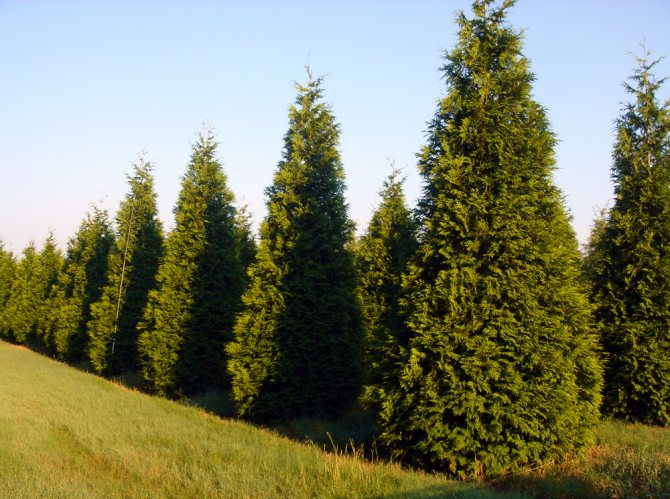

In the wild, these thuja have inconceivable dimensions - more than 50 meters. In our area, folded thuja are not so tall. Their height often reaches 12-15 meters - no more. Plants of this group do not differ in frost resistance, often part of the frozen crown has to be cut out. The crown of trees is low, it is dense, highly spreading. Emerald needles with tints.
This variety of thuja includes about 50 different varieties. All of them are used in parks (due to their vigorous growth and rapid growth).
Popular varieties
| name | characteristic |
| Whipcord | A variety of remarkable appearance: the dwarf plant has a spherical shape with long green drooping branches. It looks like an emerald rain. The trunk height is no more than 1.5 meters. In winter, the needles change color to bronze. The annual growth is small - 7-10 centimeters. Grows well in moist soil with sufficient nutrients. The cultivation of the variety is mainly local, since the lush ball alone looks the most impressive. |
| Zebrina | The sparse crown of a tall tree resembles an ordinary spruce from a distance. The plant can grow on any type of soil, but in poor soil it develops twice as slow. Lateral shoots grow in a drooping state, skeletal branches are broadly spreading, with a scaly light green crown. Suitable for single planting. |
Thuja Japanese or Standish (Thuja standishii)
It grows in the vastness of Japan. A moisture-loving plant that loves abundant sun and fertile soil. Does not tolerate severe frosts well, but has a negative attitude towards drought. Grows mostly singly in well-lit areas.
note: The Japanese consider this type of thuja sacred. In ancient times, it was forbidden to cut down the tree.
The Japanese thuja is a tall, pyramid-shaped tree. It has a wide base and a narrow apex. The bark is blood-burgundy, it is loose, peels off strongly with age. The needles are matte green with a whitish tint. The height of the wild tree is over 20 meters. The cultivated variety has a modest size - only 6-9 meters.
Thuja Korean (Thuja koraiensis)


7-8 meter tree or shrub plant with a conical crown. As you can imagine, it grows on Korean soil. It is considered a winter-hardy type of thuja. The needles are light in color. Numerous branches are soft, growing at an angle from the trunk. The bark is reddish, rough. Thanks to the long side shoots, a volumetric appearance is created, which gives the plant a little chaos, since thin branches sometimes overlap each other, "mix". Korean thuja grows on mountain slopes and in coniferous forests.
How to care for a thuja after planting
This shrub can be attributed to unpretentious crops with simple cultivation techniques. However, he still needs minimal care, especially in the first time after planting in spring and summer in a permanent place in the garden. To properly care for thuja outdoors, you must follow simple rules:
- Watering you need to do it regularly, the approximate frequency is about once a week, using 3-4 buckets under one bush, more often in hot and dry weather.This culture is very fond of sprinkling, it must be periodically done, especially in hot and dry times, but it should be watered with sprinkling strictly early in the morning or in the evening when the sun goes down.
- If the soil settles after planting after a while, then you need fill up the earth to the previous level.
Advice! The shrub after spring planting is under stress, it is especially vulnerable. Therefore, it is very important to protect the thuja from bright sunlight. To do this, you need to put some kind of frame around it, for example, arcs, and stretch burlap or agrofibre for the first time (about 1-2 weeks). In this case, the covering material should be near, but not in any way in contact with the plant itself!
- Mulching very useful for any shrub. It keeps the soil moist for a long time, protects the roots from overheating. As noted above, you can mulch with coniferous litter, pine bark, peat. The thickness of the mulch is 7-10 centimeters.
- If you are mulching, then you need loosen the soil of the trunk circle... Loosening is recommended after watering or rains to a depth of 5 centimeters.
- It is necessary in a timely manner weed the weeds, they should not be allowed to grow.
- If you filled the hole well before spring planting, then in the first 6-12 months you do not need to worry about top dressing. After that, you can use special fertilizers for conifers.
- Shelter in the fall before the winter cold is very important, it will protect plants from cold weather and bad weather. First of all, you need to cover the root system, that is, mulch (layer about 10 cm). It is recommended to cover small seedlings in the first year with a cut 5-liter bottle. Older plants can be wrapped in agrofibre (it protects from wind and partly from ultraviolet radiation). But materials that completely do not allow light to pass through cannot be used, because thuja is an evergreen plant and the processes of photosynthesis take place in it all year round.
Wintering a tree
The shrub is completely unpretentious and tolerates low temperatures down to -40 ° C during wintering. But at the same time, it is still recommended to cover young 2-3-year-old and weakened plants for the winter. This is necessary in order to protect against ultraviolet radiation and snow. For shelter, you can use gauze, kraft paper, burlap, polymer mesh or cotton fabric, which do not allow ultraviolet rays to pass through.
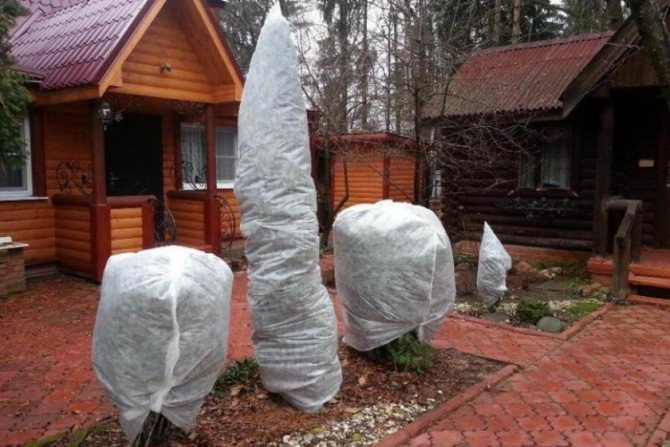

For this purpose, the plant is completely covered with one of the above materials in several layers and tied tight with a rope. Shelter must be carried out very carefully so as not to damage the thuja branches.
Important! In the transitional winter-spring period, due to aggressive sun rays, thuja can get burns, which can lead to the death of the plant.
The presence of thuja will decorate any garden, especially if you give the bush a pretentious shape, emphasizing the general concept of plantings. At the same time, the shrub is relatively not picky about growing and breeding conditions. The plant does not require special care and takes root well in regions with different climates. Thanks to these qualities, thuja is very popular among gardeners.
Features of planting thuja in summer
You can plant a crop in open ground in the summer. But in a hot period, you need to be especially careful, otherwise the seedling may simply not take root.
Rules for planting a thuja seedling in the summer and subsequent care:
- The seedling must have closed root systemeg in a pot, container, special bag.
- After purchasing the planting material, you should not rush, it is recommended to leave the seedling in the shade for several days.
- The landing pattern itself is conventional.
- The optimal planting time in the summer is cloudy, rainy day... If such weather is not foreseen, then it is better to do it at least in the evening.
- The first time after the procedure, you need to carefully look after the young shrub in the open field, namely water regularly... At the same time, watering should be abundant, more than the usual rate, only with the help of life-giving moisture can the seedling take root!
- For better rooting, it is recommended that after performing the event, water it several times not just with water, but solution "Kornevin".
- Since summer planting is stressful for a thuja seedling, there is always a risk that it will not take root in the open field. To help the plant overcome stress, it is recommended that spraying with growth stimulante.g. Zircon, Epin-Extra, HB-101. But you can spray only in the evening, when the sun has already gone down, or early in the morning, or on a cloudy day!
- First 2-3 weeks needed shade plant from the sun's rays. For example, you can make a protective screen from high density paper, plywood.
- Since moisture evaporates much faster in summer, it is recommended mulch the soil around the bush. Firstly, moisture will evaporate more slowly (this is very important for a young plant!), And secondly, the root system will be protected from overheating. The optimal mulch layer is 7-10 cm; for example, rotted sawdust, coconut fiber can be used.
Note! Despite the fact that it is possible to plant thuja in the summer, and many summer residents and gardeners do it, you still need to do it carefully! Due to the high temperature, drought, active sun rays, the seedling may not take root, so it is very important to provide it with the most gentle care after the procedure!
Planting coniferous shrubs in open ground in spring and summer, and caring for thuja in the country is very simple. The procedure, of course, has its own characteristics and rules, but in general, if you follow the step-by-step instructions for planting and perform each step efficiently, even a novice gardener is doomed to success.
Preparing for hibernation
Thuja is a representative of those cultures that are very rarely exposed to frost. Only young plants may need light cover for the winter.
However, in winter, a completely different attack awaits the thuyu. Under its own weight, the snow making its way into the crown can bend the branches, as a result of which they gradually move away from the trunk or may break off altogether. Therefore, where there are especially snowy winters, it is advisable to tie the plants with a beautiful shape (not tightly) with twine, which will help to press the branches and block the way for the snow inside the crown.

